How does a septic tank work
It is hard to imagine comfortable living in a country house without the benefits of civilization, such as a bathroom, shower and toilet. Therefore, the main issue for owners of individual buildings is the removal and disposal of wastewater without harm to the environment. And if earlier, in most cases, cesspools or sewage wells were equipped to remove sewage, today, improvement of any country buildings, summer houses in the absence of a central sewage system is carried out by making home-made or installing autonomous treatment systems, the main element of which is a septic tank. Consider what a septic tank is, its structure and the principle of operation of a local cleaning system, or in other words, we will study how a septic tank works.
What is a septic tank
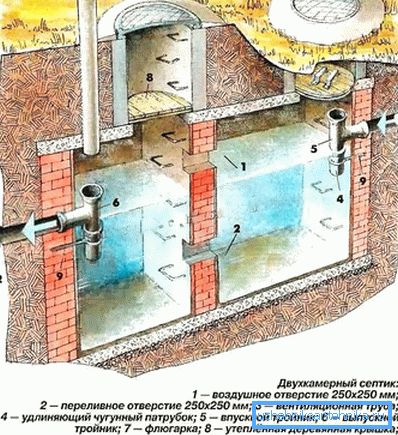
The septic tank is the main element of the autonomous cleaning (sewage) system of low-rise individual buildings, which is designed to collect and clean household, sewage and sewage. Installation of a septic tank for sewage is performed in case of absence or impossibility of connection to the central cleaning system. Local sewer systems have an affordable cost, compact size, high operational and quality parameters. An autonomous treatment plant consists of a tank, which may be concrete, metal or plastic (polypropylene). In addition, each material has its own advantages and disadvantages.
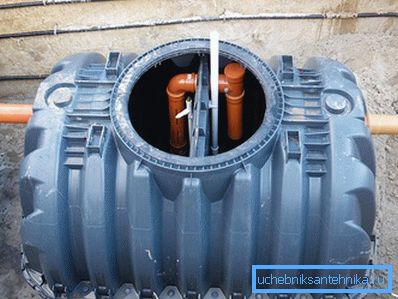
Plastic containers are lightweight, easy to install, are not susceptible to corrosion, but due to the small mass in the event of improper installation can be pushed to the surface by groundwater. The process of installing reinforced concrete cleaning septic tanks is more complex, time-consuming, but at the same time, this design has greater reliability, is not pushed out by groundwater, can withstand substantial loads, and is not subject to corrosive processes. Septic tanks made of metal stronger plastic structures, but susceptible to corrosion.
Septic tanks have a different volume and, depending on the model, can be:
- single chamber;
- two-chamber;
- three-chamber.
When choosing a septic tank, it is necessary to take into account the number of permanently living people, the principle of operation of the local purification system, the depth of groundwater location, the particular topography of the terrain, the qualitative characteristics of the soil, and the design of a particular purification model. When choosing a septic tank, you must also take into account the daily volume of wastewater:
- If the daily discharge flow is less than 1 m3 - one-chamber capacity without bottom is quite enough.
- If the volume exceeds 1 m3/ day - establish a two-or three-chamber septic tank.
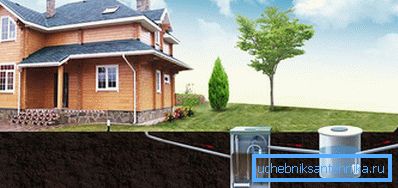
The main advantages of using septic tanks include:
- efficient, fast wastewater treatment from pollution. Even the simplest septic tank cleans drains by 70–80%;
- possibility of installation in any climatic and weather conditions;
- ease of installation and maintenance. Having experience and skills in carrying out construction work, you can install the local sewer system on your own;
- no need for frequent pumping;
- long service life, but only with proper installation and operation;
- Some models of septic tank are independent of the power supply system.
The principle of operation of autonomous sewer systems
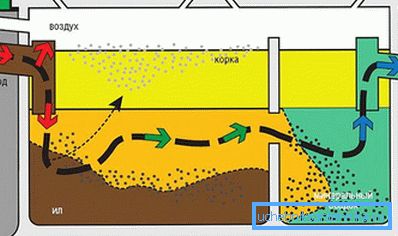
To ensure the efficient operation of the sewer system and to carry out the installation correctly, it is necessary to know how the septic tank works. A septic tank may consist of one, two or three hermetic chambers tightly closed by a hatch, in which the wastewater treatment takes place. The hermetic design prevents the spread of unpleasant odors around the cleaning system. The sanitary and hygienic condition of the site depends on the proper installation and the efficiency of the septic tank.
The principle of operation of the sewage treatment plant consists in multistage sewage treatment, separation of sewage into several fractions. That is, in the tanks of the system, solid masses are separated from the liquid medium, followed by sludge processing and water filtration. Thus, the output is purified water at 70–90% of the initial state. Consider the principle of operation on the example of a three-chamber reinforced concrete septic tank. The scheme of this facility includes two or three chambers, built of reinforced concrete rings, in which settling occurs, cleaning of wastewater, as well as from a filtration well (filtration field).
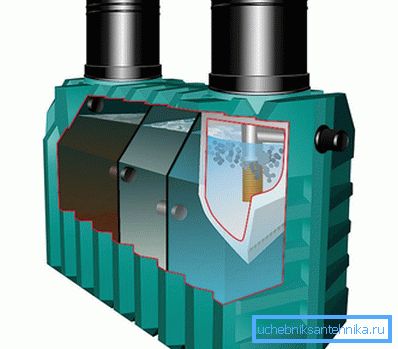
The septic tank chambers are divided by partitions. In the first chamber through the sewer pipe runoff. The first section of the septic tank performs the role of primary, rough cleaning of the falling drains. At the bottom of the tank, large fractions, sand, and residues of household waste are deposited; sewage is divided into solid and liquid fractions. Larger and heavier particles settle at the bottom, lighter rises to the top. In the second settling chamber, further purification and clarification of the effluent takes place. Fermentation of wastewater occurs without oxygen access, under the influence of anaerobic microorganisms. Thus, in the second tank, decomposition, purification of organic waste, sedimentation of mechanical impurities, chemical compounds, clarification of wastewater take place.
In the third compartment, the final wastewater clarification process takes place. After septic treatment, wastewaters are sent to the soil tertiary treatment. At the exit of the cleaning structure, additional drainage structures are installed, which can be represented:
- filtration fields;
- absorbent wells;
- infiltrators.
Each of the above systems has its own structural features, and the principle of their operation is based on soil water purification. Drainage structures are selected on the basis of the terrain features, soil structure, level of occurrence and freezing of groundwater. In the filtration fields install backfill filter of rubble, sand, gravel, expanded clay. On the backfill, bacteria form a so-called biofilter, on which tiny organic particles accumulate. The main condition of the ground treatment is the presence of oxygen, which is necessary for the vital activity and activity of aerobic bacteria. The greater the access of oxygen to wastewater, the faster the oxidation and their clarification.
We also want to invite you to read the articles that tell about the manufacture of septic tanks:
- Septic tank of their own.
- Septic tank for giving without pumping the hands.
- Septic tank for high groundwater do it yourself.
Video
This video describes the working principle of the Septic "Rostock" Suburban: